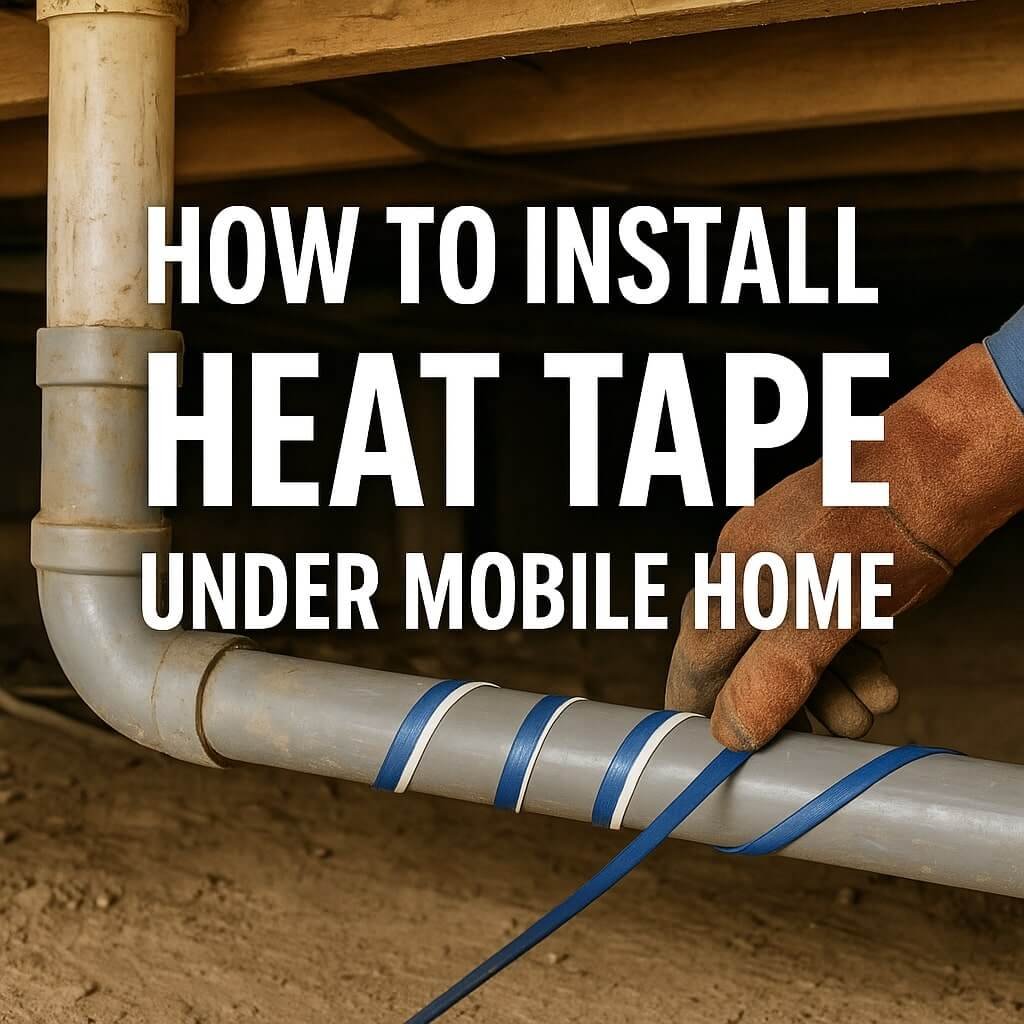When winter hits hard, the last thing you want is for the water pipes under your mobile home to freeze and burst. That’s where heat tape comes in. Learning how to install heat tape under a mobile home is not only essential for keeping your water flowing but also for avoiding costly repairs.
This comprehensive guide walks you through everything from choosing the right kind of tape to expert tips on a safe installation. Let’s dive into the basics first.
Why Mobile Homes Need Heat Tape
Unlike traditional houses, mobile homes often have exposed plumbing beneath the structure. These pipes are highly susceptible to freezing in cold weather, which can lead to:
- Burst pipes
- Water damage
- Expensive emergency repairs
- No running water
Heat tape prevents this by warming the pipes just enough to keep water flowing, even in subzero temperatures.
Understanding the Types of Heat Tape
Knowing your options can save you time and money. Here’s a breakdown of the main types available:
Self-Regulating vs Constant Wattage Heat Tape
| Type | Description | Best For |
|---|---|---|
| Self-Regulating | Adjusts heat output based on temperature | Energy efficiency, fluctuating weather |
| Constant Wattage | Delivers consistent heat | Severe cold conditions |
Self-regulating tape is more energy-efficient, while constant wattage types are better suited for extreme cold.
Pre-assembled Plug-in vs Hardwired Tape
- Plug-in: Ideal for DIY installation. Comes ready with a thermostat and plug.
- Hardwired: Requires professional installation. Best for permanent setups.
Tools and Materials Needed
Before you start, gather the following:
- Heat tape (self-regulating or constant)
- Electrical tape or cable ties
- Pipe insulation
- Measuring tape
- Scissors or a utility knife
- GFCI outlet (for plug-in models)
- Safety gloves
Optional: Infrared thermometer to check pipe temperature post-installation.
Safety Precautions Before You Start
Safety comes first. Take these precautions:
- Unplug everything before working near electrical components.
- Never overlap heat tape—it can overheat.
- Only use heat tape designed for water pipes, not roofing or gutters.
- Check compatibility with plastic or metal pipes.
- Follow the manufacturer’s instructions for the specific tape type.
Step-by-Step Installation Process
Step 1: Measure Your Pipes
Use a measuring tape to determine the length of all exposed pipes. Add extra for bends and valves. This ensures you buy enough tape.
Step 2: Choose the Right Heat Tape
Select the appropriate type based on:
- Pipe material (PVC or metal)
- Climate severity
- Availability of power sources
Step 3: Clean and Prepare the Area
Wipe down the pipes to remove any dirt or moisture. Clean pipes ensure better adhesion and heat transfer.
Step 4: Install Heat Tape Properly
- Lay the tape flat along the pipe or spiral it evenly.
- Never wrap over itself.
- Use electrical tape or cable ties every 12 inches to secure it.
Step 5: Add Insulation Over Pipes
Wrap foam pipe insulation over the heat tape. This helps retain heat and increases efficiency. Seal seams with duct tape.
Step 6: Secure and Power Up
- Plug the tape into a GFCI outlet.
- If hardwired, ensure it’s professionally connected.
- Secure loose wires to prevent hazards.
Step 7: Test the Installation
Use an infrared thermometer or feel the pipe to confirm it’s warming. If not, check the thermostat and power supply.
Common Mistakes to Avoid
Even a minor mistake in installation can render the heat tape ineffective or dangerous. Avoid these common pitfalls:
- Overlapping heat tape: This can cause the tape to overheat and fail.
- Using the wrong tape type: Not all heat tapes are compatible with all pipe materials.
- Poor insulation: Skipping insulation can lead to heat loss and reduce efficiency.
- Improper power source: Always use a GFCI-protected outlet to prevent electrical hazards.
- Not securing the tape properly: Loose tape can sag, causing uneven heating and potential hazards.
How to Maintain a Heat Tape System
Heat tape systems, while mostly low-maintenance, still benefit from occasional checks, especially before and during winter:
- Inspect annually: Look for signs of wear, damage, or corrosion.
- Test functionality: Turn it on early in the season to ensure it heats.
- Replace insulation: Damaged or wet insulation should be replaced immediately.
- Keep connections dry: Moisture near electrical connections is dangerous.
- Clear debris: Remove any leaves, trash, or animal nests from under the mobile home.
Energy Efficiency Tips
You don’t have to sacrifice warmth for energy savings. Try these tips:
- Use self-regulating heat tape: It adjusts output based on temperature.
- Install a timer or thermostat: Automatically turns the tape off when not needed.
- Insulate thoroughly: Keeps more heat in, so the tape works less.
- Seal skirting: Prevents cold drafts from reaching your pipes.
- Use solar-powered solutions (if feasible): Offset electricity usage with solar energy.
Troubleshooting Heat Tape Issues
When your system doesn’t work as expected, use this troubleshooting checklist:
| Problem | Possible Cause | Solution |
|---|---|---|
| Tape not heating | Power source issue | The tape shorted out |
| Uneven heat | Poor installation or overlaps | Reinstall properly |
| Tape shorted out | Water intrusion or damaged cable | Check the plug, breaker, and outlet |
| Constant heating | No thermostat/timer | Add a controller to regulate usage |
Still having trouble? Consult a licensed electrician, especially for hardwired setups.
Frequently Asked Questions (FAQs)
1. Can I install heat tape on PVC pipes?
Yes, but ensure the heat tape is labelled safe for use with plastic pipes. Also, never exceed the pipe’s maximum temperature tolerance.
2. How long does heat tape last?
Most heat tape lasts 3 to 5 years, depending on usage, brand, and environmental conditions. Annual checks help prolong its life.
3. Should I leave the heat tape plugged in all winter?
If it’s thermostat-controlled, it’s safe to leave plugged in. Manual models should be turned on only during freezing temperatures.
4. Do I need insulation over the heat tape?
Absolutely. Insulation ensures the tape works efficiently and minimises heat loss. Use foam or fibreglass sleeves rated for pipe use.
5. Can heat tape cause a fire?
While rare, it’s possible, mainly due to improper installation, overlaps, or damaged wiring. Always follow the manufacturer’s guidelines.
6. Where can I buy reliable heat tape?
You can find quality heat tape at home improvement stores like Home Depot or online on Amazon. Look for UL-listed options for safety.
Conclusion
Installing heat tape under your mobile home is one of the smartest ways to safeguard your plumbing during the winter months. By following the proper steps, using the right materials, and adhering to safety measures, you can protect your pipes from freezing, save on repairs, and ensure an uninterrupted water supply.
This process is manageable for most DIYers, but always consult a professional if in doubt, especially with electrical connections. Don’t wait for winter’s worst; prepare now and enjoy peace of mind through the coldest days.













